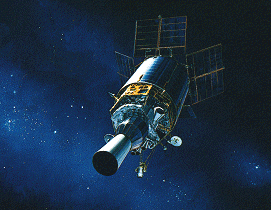
DEFENSE SUPPORT PROGRAM
Air Force Space Command-operated Defense Support Program satellites are a key part of North America's early warning systems. In their 22,000 miles-plus geosynchronous orbits, these satellites help protect the United States and its allies by detecting missile launches, space launches and nuclear detonations.
Defense Support Program satellites use an infrared sensor to detect heat from missile and booster plumes against the Earth's background.
The program came to life with the first launch of a Defense Support Program satellite in the early 1970's. Since that time, Defense Support Program satellites have provided an uninterrupted early warning capability.
Defense Support Program's effectiveness
was proven during the Persian Gulf conflict, when Defense Support Program satellites
detected the launch of Iraqi Scud missiles and provided warning to civilian populations
and coalition forces in Israel and Saudi Arabia.
In 1995, a new means of processing Defense Support Program data was brought on line. This Attack and Launch Early Reporting to Theater capability provides improved warning of attack by short-range missiles against U.S. and Allied forces overseas.
The 21st Space Wing, located at Peterson Air Force Base, Colorado, has units that operate Defense Support Program satellites and report warning information, via communications links, to the North American Aerospace Defense Command (NORAD) and the U. S. Space Command early warning centers within Cheyenne Mountain, located near Colorado Springs, Colorado. These centers immediately forward data to various agencies and areas of operations around the world.
The 50th Space Wing located at Falcon Air Force Base, Colorado, provides command and control support for the satellites.
Air Force Materiel Command's Space and Missile Systems Center at Los Angeles Air Force Base, California, is responsible for development and acquisition of Defense Support Program satellites.
Numerous improvement projects have enabled Defense Support Program to provide accurate, reliable data in the face of evolving missile threats. In the 21st century, the Space Based Infrared System is expected to replace Defense Support Program.
SPECIFICATIONS
Weight: 5,000 pounds (approximate)
Orbit Altitude: 22,000 miles (approximate)
Power Plant: Solar arrays
Dimension: 22 feet diameter, 32.8 feet high (with solar arrays deployed)
Primary Contractor: TRW
Current as of July 1995
 Return to US
Space Command Home Page
Return to US
Space Command Home Page
| First Page | Prev Page | Next Page | Back
to Text |